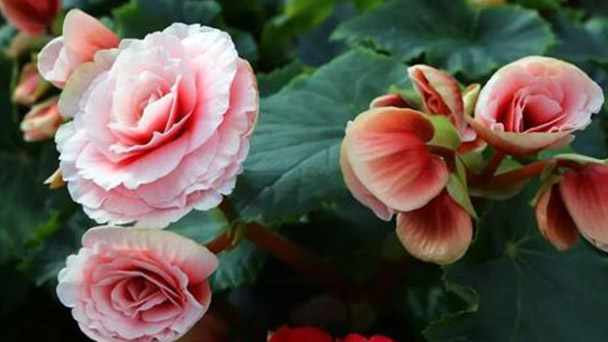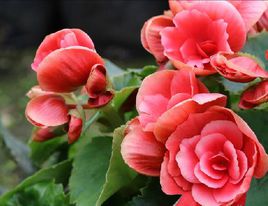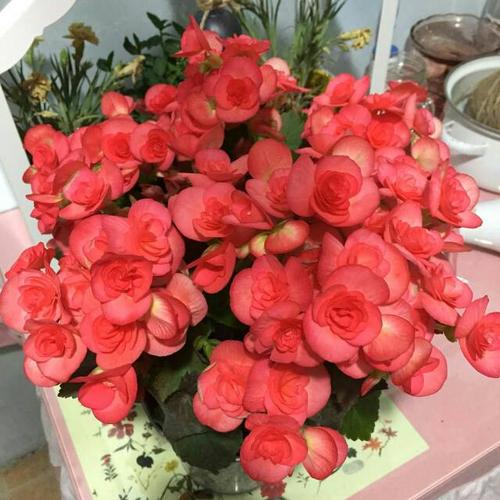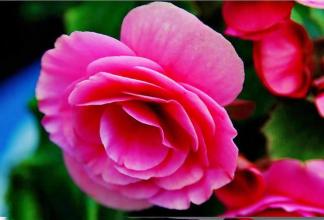Elatior Begonia Care Tips & Propagation Guide
Written by Maggie
Nov 08 2021

Elatior Begonia not only has large and colorful flowers but also has a long flowering period that can last for about half a year as an indoor ornamental flower in winter and spring. Elatior Begonia is not easy to grow. When it is planted, yellow leaves and dry leaves often appear, and then it can only be harvested in an empty pot. So, how to care for Elatior Begonia to be a beautiful plant shape and flowers? In fact, if care properly, it is not difficult to grow a good Elatior Begonia plant. The following are Elatior Begonia care tips.

Elatior Begonia Temperature Care
Elatior Begonia is not cold resistant. The temperature of normal growth and flowering is 15℃~22℃. When we grow and care for elatior begonia in winter, the temperature should not be lower than 10℃, otherwise, the growth is slow and the flowering will be affected.
However, if you want Elatior Begonia to blossom constantly and have delicate colors, the indoor curing temperature should not be lower than 16℃.
If you keep Elatior Begonia indoors in the north, the temperature is suitable. As long as it is properly maintained, the flowers will blossom constantly. However, when we grow and care for Elatior Begonia in the south indoors, it is necessary to pay attention to heat preservation, and do not place it in the window or windy place at night.
Elatior Begonia Lighting
Elatior Begonia can withstand a semi-cloudy environment. When we care for Elatior Begonia in winter, it is appropriate to place it in the windowsill or balcony facing south for maintenance, to receive sufficient light, which is conducive to flowering. Early at the end of spring and summer, as the enhancement of ultraviolet rays, adjust to put the position again.
When the planting environment is not illuminated or dark, Elatior Begonia will grow fruitless, and the leaves will turn yellow and fall due to the failure of normal photosynthesis, and the flowers will be dim and the flowering period will be short.
Elatior Begonia Watering
Elatior Begonia does not tolerate drought and is afraid of standing water. If the basin soil is too dry, the leaves of Elatior Begonia will turn yellow, and the buds will fall when it is serious. The basin soil is too wet, can cause the stem to rot, or produce diseases and insect pests.
Therefore, when we grow and care for Elatior Begonia in winter, watering should be done according to the indoor temperature and ventilation environment. In the northern heating room, water should be poured once every 3 to 4 days. After the basin soil is dry, water should be added in time, and the water in the tray should be poured out.

Elatior Begonia Fertilizer
When we grow and care for Elatior Begonia, Elatior Begonia should be fertilized thinly and frequently, so as to ensure sufficient nutrient supply in the growing period, so as to promote the growth of Elatior Begonia to be more solid. In the flowering period, Elatior Begonia can blossom continuously.
During the flowering period, Elatior Begonia can be supplemented with dilute fertilizer once or twice a month. When we grow and care for Elatior Begonia, the decaying cake fertilizer and potassium dihydrogen phosphate can be used alternately, which can not only promote the growth of branches of Elatior Begonia, but also ensure the nutrients needed for flowering.
Elatior Begonia Soil Care
Many people will change the soil when they first buy the Elatior Begonia. However, it is very unfriendly to the flowers in bloom. Because they need to consume energy in the flowering period. If the replacement of pot soil at this time, it will make them in the process of serving the pot, both to serve the pot, but also to blossom, the loss is great, the time for serving the pot will be very long, and even cause falling buds and flowers.
Therefore, when we care for the Elatior Begonia that we just bought from the shop, we should not change the pot first, and then change the pot after the flowers.
Elatior Begonia Repotting
Most Elatior Begonia are grown in plastic pots of 12 or 13 cm. When transplanting, Elatior Begonia seedlings should be carefully removed from the hole disc to minimize mechanical damage to roots and leaves of seedlings. Elatior Begonia Seedlings gently placed in the basin, gently add substrate around the seedlings, gently press along the edge of the basin with your hand, must not press down the base of the seedlings, so as not to break the root system.
Elatior Begonia Pruning
Usually, Elatior Begonia will grow many branches. It can promote the germination of lateral branches by artificial heart picking for those unshaped Elatior Begonia plants. Generally, the terminal bud is removed 2 weeks after the pot shift of the seedlings, that is, when the third to the fourth leaf of the plant is expanded, and the lateral branches are germinated from the base to make the plant shape plumper. Picking buds repeatedly 2 ~ 3 times is almost ok. Picking too many times will lead to insufficient nutrient supply. Due to the formation of flower buds in the small Elatior Begonia seedling stage, redundant flower storage should be removed in time to reduce the extra consumption of nutrients, prolong the light time to promote nutritional growth, and make the Elatior Begonia plant shape more neat and beautiful. At the same time, in the whole growth process, timely finishing leaves, thinning buds, remove diseased leaves and old leaves, and every 2~3 turnover 1 pot, in order to keep the plant exposure to sunlight evenly.Elatior Begonia Pest & Disease Care
There are fewer pests and diseases when growing Elatior Begonia at home. Fungicides can be sprayed regularly to prevent bacterial soft rot and powdery mildew. Agricultural streptomycin can be used as 200ug/g tadoinazol 1000 times liquid spray. In order to prevent pesticide pollution of the air in the family, some pesticides can be homemade, while the prevention and control effect is good. The common ways are as follows:(1) Ginger juice and water, with a ratio of 1:25 spray, can prevent the germination of Elatior Begonia soft rot and other pathogenic spores.
(2) Dry pepper 50 grams, add 50 times the water, cook for half an hour, take the supernatant spray foliar, can effectively prevent aphid, red spider, mite, inhibit plant growth, make the new Elatior Begonia leaves become hard or linear.
Elatior Begonia Propagation
Elatior Begonia Propagation from Seed
Because the seeds of Elatior Begonia are very small. When sowing, put the substrate into the seedling tray, and then pour water through the watering can. Then scatter the Elatior Begonia seeds in trays. After sowing, there is no need to cover soil, only fine spray can, and then use transparent plastic film to wrap the seedling tray. At an ambient temperature of 20℃, Elatior begonia began to emerge after 12 days. When the seedlings grow true leaves, it can be properly ventilated, promote its roots. The seedlings grow slowly in the first three months. Seedlings sown in early summer do not have to remove the plastic film throughout the summer. Elatior begonia seedlings are resistant to high humidity and high temperature. After the start of autumn, the weather is cool, gradually remove the plastic film refining seedlings, to the early winter Elatior begonia seedling can be on the basin. Use small bottom porous flowerpot, controlling watering, make the cultivation soil of seedling plate is in half dry state, avoid the seedling is not scattered and hurt the root. Elatior Begonia seedlings that have just been potted should be protected against weather changes and high temperatures. They should also be covered with plastic film, but not too tightly, and properly ventilated to prevent rotting seedlings. Elatior Begonia will not grow into a large plant when grow in a home, but it can flower. It takes another year to grow into a large plant, which can be changed to a larger pot.
Elatior Begonia Propagation from Cutting
In late fall and early winter, the branches from Elatior Begonia can be used as cuttings when the plants are pruned. Elatior Begonia can be propagated with sticks cuttings or leaf cutting. When the branch is inserted, the length of the branch should be moderate, and the lower part of the branch should be cut into a horseshoe shape with a blade; When inserting leaves, choose vigorous and mature leaves of six minutes and cut the lower end of petiole diagonally with a blade. The Elatior Begonia cutting matrix is vermiculite powder or plain sand, and the polluted matrix should be disinfected and reused. Insert cuttings to water permeable, but do not water on the leaf surface. And cover it with plastic film, put in the scattered light, proper ventilation, avoid high temperature. Elatior Begonia cuttings can start roots in about 3 weeks. When you see new leaves growing out, you have roots. Elatior Begonia plants obtained by grafting did not have underground tubers. After 3 weeks of leaf insertion, fibrous roots can also grow at the lower part of petiole, but it takes another one and a half months to grow adventitious buds from under petiole, and gradually unearthed.
Elatior Begonia Tissue Propagation
Tissue propagation method is a rapid method to obtain a large number of Elatior Begonia flower seedlings. In the growth season, a large number of Elatior Begonia free seedlings could be obtained by using well-developed leaves as explants in certain medium, through culture of non-toxic explants, subculture and rooting culture. This method has a large input and is only used in mass production.
Elatior Begonia Care FAQs
Elatior Begonia Care in Winter
Elatior Begonia likes to live in a warm and wet environment and does not tolerate cold. If Elatior Begonia is left outside in winter, it will easily freeze to death. In winter, when the outdoor temperature is relatively low, Elatior Begonia is not cold resistant. Therefore, in winter, it is best to move the plant indoors for care and take some measures to keep warm, but it must be careful not to place the plant next to the heater. In winter, due to the low temperature, Elatior Begonia will enter the dormant stage, so we should water Elatior Begonia less at this time, and when watering Elatior Begonia, we should water Elatior Begonia from the root to avoid spraying water on the leaves. Meanwhile, Elatior Begonia is very slow-growing and basically doesn't grow at all, so stop fertilizing, but spray around it to keep the air moist.

How Long will Elatior Begonia Live
Elatior Begonia is a perennial herbaceous flower that can continue to bloom and grow as long as it is properly cared for. Elatior Begonia has a long flowering period and is an excellent flower-watching plant in winter. Elatior Begonia can live for 2-3 years if it is properly maintained. But Elatior Begonia is half-dead in winter, so in winter, in addition to keeping the plant warm, we also need to keep the air moist. If the weather is dry, we can spray mist around the pot to increase the humidity.
Read more: Elatior Begonia Profile
How to Propagate Elatior Begonia
Latest Updated
- Benefits of Bugleweed - 7 Science-backed Health Benefits
- Bugleweed Dangers & Side Effects - Is It Poisonous?
- How to Plant Evergreen Trees - What You Should Know
- When to Plant Evergreens - Grow Guide for Evergreen Trees
- 12 Wonderful Evergreen Shrubs for Your Garden
- 12 Popular Evergreen Plants with Pictures for Beginners
- When And How To Prune A Lilac Bush Like a Pro
- How to Grow & Care for Lilac Vine (Hardenbergia Violacea)
- Japanese Lilac Tree (Syringa Reticulata) Care & Propagation Guide
- Shumard Oak Pros and Cons - What to Know
Popular Articles
- Winter maintenance of Antirrhinum Majus
- How to Grow Terminalia Mantaly Tree
- How to Grow and Care for Crossostephium Chinense
- How to grow Antirrhinum Majus in spring
- Peristeria Elata (Dove Orchid) Profile: Info & Care Guide
- Underwatered Snake Plant (Sansevieria Trifasciata) - Signs And How To Fix
- How to Care for Brazilian Jasmine Plant (Mandevilla Sanderi)
- How to Grow & Care for Graptopetalum Purple Delight in Summer
- Rosa Chinensis (China Rose): Plant Growing & Care Tips
- How to Care for Baby Sun Rose (Aptenia Cordifolia)